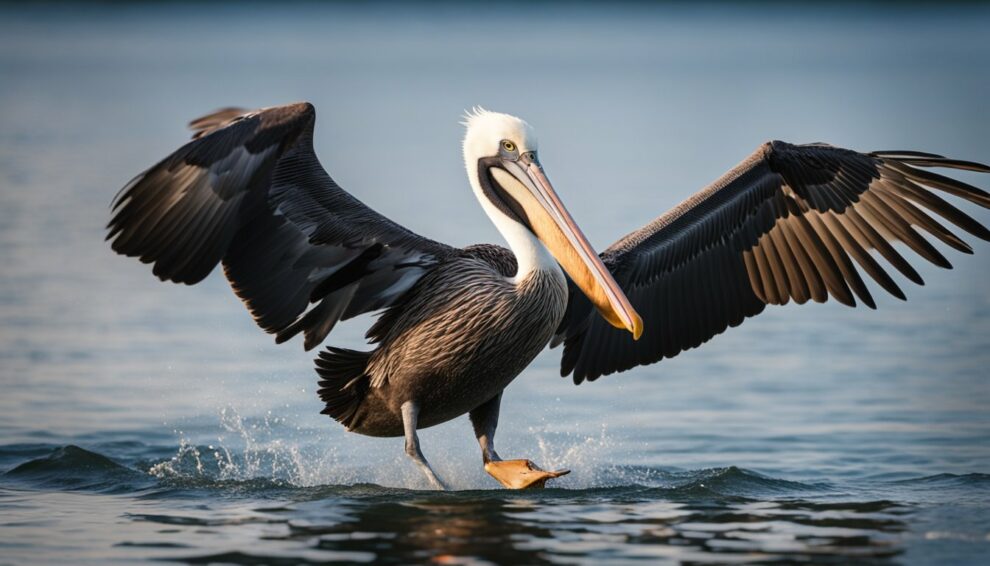Pelicans are nature’s expert fishermen, equipped with an intriguing tool that sets them apart from other birds – their pouch.
Picture this: a pelican glides gracefully above the water, scouting for its next meal with eyes sharper than a hawk’s. In a split second, the bird spots its target and readies itself for action.
The pelican’s pouch is not just any ordinary bird beak; it’s a built-in fishing net that can stretch and expand to trap unsuspecting fish.

Have you ever seen a magicians’ hat trick, where rabbits appear out of an empty hat? Well, pelicans have a similar trick up their beak!
When it’s time to dine, they plunge headfirst into the water, scooping up fish along with gallons of water.
It may look chaotic, but there’s a method to it.
When they resurface, they have to strain all the water out of their pouch before tossing their head back to gulp down their slippery catch.
Imagine trying to keep a water balloon in your mouth, all while letting the water out without losing your treat – that’s the kind of skill these birds master.
In the wild water-dance of the pelican, teamwork often comes into play.
They may form a line and work with their feathered friends to corral the fish, making it easier to scoop them up.
It’s like a group of friends rounding up for a game – everyone has a role, and working together makes the meal a guaranteed score.
So next time you’re at the beach or a lakeside, keep an eye out for these incredible birds and their mesmerizing mealtime maneuvers.
Who knows, you might just get to witness their pouch in action, a sight as unforgettable as it is impressive!
Anatomy of the Pelican Pouch

Pelicans have a unique feature that sets them apart from other birds: their pouch.
This stretchy, expandable sack isn’t just for show; it’s a crucial tool for their survival.
Let’s unpack the marvels of this specialized structure.
Structure and Function
The pelican’s bill is not just the garden-variety beak.
The lower mandible is connected to a flexible pouch, which, in technical terms, is called the gular pouch.
The tissue of the pouch is an intricate network of muscle fibers, capable of stretching to a remarkable size.
Think of it as an inbuilt fishing net, where instead of tangled lines, pelicans use their respiratory system to control the pouch.
When encountering a school of fish, a pelican will gracefully glide over the water and scoop up its prey along with water.
Muscles around the pouch then contract to push the water out while keeping the fish trapped inside.
Did you know that a pelican’s pouch can hold up to three times more than its stomach?
Imagine having a lunch box three times bigger than your belly!
Breathing While Fishing
Now you might wonder, how does a pelican breathe when its bill is submerged, and its throat is bulging with water and fish?
Well, these birds are well-equipped for such a task. Surrounding their throat and under the bill, pelicans have air sacs.
These are not like the balloons you play with; these sacs keep the pelican buoyant and assist with respiration, particularly during the moments when their beak is busily submerged.
When they thrust their bill into water, the air sacs help to keep their heads afloat, ensuring that they can still take a breath at the corner of their mouths.
That way, a pelican can keep fishing without missing a gulp of fresh air.
Next time you see a pelican fishing, pay attention to how it manages to keep breathing while its pouch is full – it’s like watching a magician who never reveals his secrets.
Fishing Tactics of Pelicans
Pelicans are adept at using their unique features to fish effectively.
They have evolved different methods to catch their prey, relying on their large bill pouches and social behavior.
Diverse Hunting Strategies
The Brown Pelican primarily uses a spectacular plunge-diving technique to capture fish.
They climb high above the water, eye their target with precision, and dive headfirst into shallow water, enveloping fish within their bill pouch.
The impact would stun most birds, but they have air sacs under their skin in their breast that cushion the blow.
After scooping up the fish and water, they’ll drain the water from their pouch and swallow their prey whole.
These birds are visual hunters; their keen sight allows them to time their dives accurately to maximize their catch.
In contrast, the American White Pelican rarely dives.
They prefer a more cooperative method, working in groups to form a line or a “U” shape and driving fish towards the shallows before scooping them up with their large pouches.
This is a less dramatic but equally effective fishing strategy, known as “herding,” that shows the intelligence and sociable nature of these white-feathered pelicans.
Collaborative Feeding Habits
While the American White Pelican enjoys group fishing, the Dalmatian Pelican may also participate in cooperative behaviors during feeding.
When these water birds fish in groups, they can often be seen swimming in coordinated lines or circles to corral fish.
This group effort not only increases the chance of a successful catch for each individual but also demonstrates the pelicans’ reliance on one another for survival.
Their teamwork is an interesting contrast to the more solitary fishing technique of the Brown Pelican and highlights the versatility within pelican species.
One might wonder if watching a video of pelicans fishing can capture the same sense of awe that witnessing it in person does.
There’s something undeniably exciting about seeing them ride the wave’s crest or beat their wings in unison as they close in on an unsuspecting school of fish.
These live-action sequences of pelican feeding frenzy offer a glimpse into the complex behaviors and social dynamics of these intriguing water birds.
Conservation and Human Impact

Pelicans navigate a world where the actions of humans have considerable effects on their survival.
This section explores the specific challenges that pelicans face and the ongoing efforts to ensure their future.
Threats to Pelican Populations
Pelicans suffer from a range of human-induced threats.
Pollution is a significant factor, with pesticides like DDT having previously caused catastrophic declines in pelican populations by thinning their eggshells.
Although DDT is now banned, other pollutants continue to pose risks, harming pelican health and their aquatic habitats.
The commercial fishing industry also inadvertently endangers pelicans; birds can become entangled in fishing gear, leading to injuries or death.
In many regions, pelican habitats are under pressure from climate change and habitat destruction.
Human disturbance can disrupt colonies, causing pelicans to abandon their nests, which reduces the survivability of their young.
These factors combined can threaten the stability of pelican populations, and in some cases, have led to species being listed as endangered.
Conservation Efforts
Thankfully, humans also play a vital role in protecting pelicans.
Conservation measures include establishing protected areas, such as the Pelican Island National Wildlife Refuge, the first of its kind in the United States, created specifically to safeguard these birds.
Governments and organizations around the world monitor pelican populations, managing habitats and restricting disturbances to bolster the number and health of colonies.
Protection efforts are making headway; for example, annual events like the Great Pelican Count involve citizens in scientific monitoring, directly engaging people in the conservation of these majestic birds.
Clean-up campaigns reduce pollution in pelican habitats, while wildlife rescue organizations rehabilitate injured birds, including those harmed by human actions.
These efforts collectively help to prevent extinction and ensure that future generations will continue to marvel at pelicans’ aerial acrobatics and spectacular fishing techniques.
Pelicans in Culture and Society

Pelicans have long been a subject of human fascination, and their presence has been woven into various cultural tapestries over time.
They are more than just birds; they carry with them a weight of symbolism and significance that stretches across different societies and historical periods.
Symbolism and Representation
In many cultures, the pelican is a symbol of self-sacrifice and charity.
This stems from a legend that dates back to ancient Christianity, suggesting that a pelican would wound itself, drawing blood to feed its young.
This powerful image has cemented pelicans as emblems of parental care and selflessness in art and storytelling.
Visitors to coastal regions of Southern California and Florida might notice pelicans during the breeding season, where these large birds gather in colonies to build their nests.
Human residents and tourists alike are often struck by the sight of pelicans gliding gracefully over the water, an image which has inspired various forms of artwork, from paintings to sculptures.
One quirky intersection of pelicans and human culture occurs in fashion.
Hats featuring pelican imagery, or even designed to mimic the shape of a pelican’s pouch, have appeared throughout history, adding a touch of whimsy and a nod to the natural world in human attire.
Pelicans also feature prominently on websites dedicated to birdwatching and ornithology, highlighting their role in ecology and their interactions with other bird species and habitats.
These online resources have become hotspots for sharing knowledge and fostering a sense of community among those passionate about these birds.
Can you imagine wearing a hat that mimics the unique bill of a pelican?
Or have you ever stumbled upon a pelican’s nest during a walk along a Southern Californian beach?
These encounters bridge the gap between the wild world of pelicans and our own human society, creating conversations and connections that last a lifetime.
Frequently Asked Questions

Pelicans are known for their unique way of fishing and the remarkable pouch that plays a critical role in it.
These questions explore the fascinating components of a pelican’s life tied closely to their feeding habits.
How does the pelican’s pouch function when catching fish?
When a pelican spots a fish, it uses its bill like a net, scooping up the fish along with a large amount of water.
The pelican then tips its head forward, letting the water drain out while retaining the fish, trapped and ready for swallowing.
What is the maximum amount of food a pelican can store in its pouch?
A pelican’s pouch is quite stretchy and can expand to hold up to three gallons of water.
When it comes to food, they can catch and store multiple fish in one dive, although the exact number depends on the size of the fish.
Can you explain the pelican’s unique diving technique during fishing?
Pelicans have perfected a high-impact fishing technique where they plunge from heights, diving headfirst into the water.
They aim at steep angles to offset refraction errors caused by the water surface, which increase their chances of catching prey.
In what ways do pelicans utilize their gular pouch to aid in feeding?
Apart from storing fish, the gular pouch’s elasticity helps control water ejection before swallowing their catch.
This sac flexibility is pivotal for their feeding success.
How do pelicans safely eat their catch without losing it?
After a successful hunt, pelicans tuck their heads down to let water drain before swallowing the fish whole.
They accomplish this without losing the catch by the clever management of their bill and throat muscles.
What adaptations do pelicans have to protect themselves in their natural habitat?
Pelicans are equipped with long bills and large throat pouches to catch fish effectively, dense bones to withstand impact, and a layer of air sacs under their skin to help them float and insulate their bodies.
Through these queries, the truly intriguing nature of pelicans is uncovered, showcasing the many features that equip these birds for their daily aquatic pursuits.









